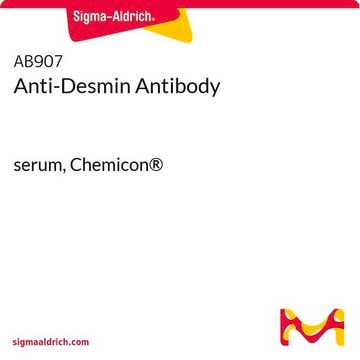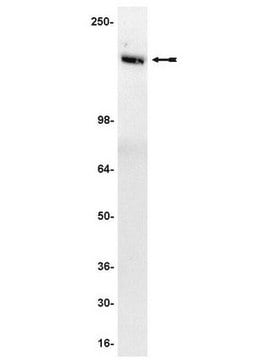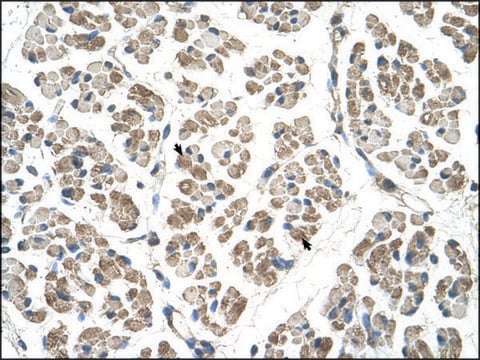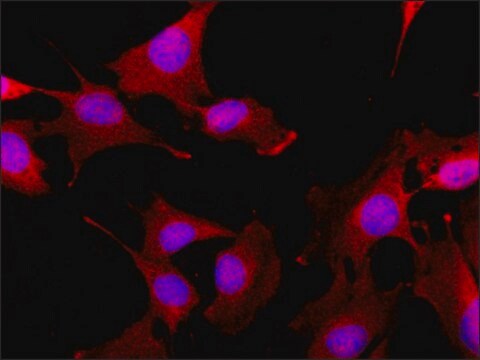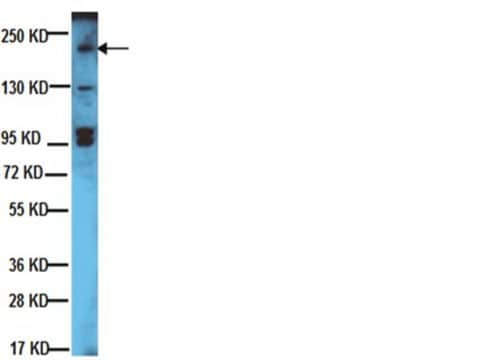MAB3430
Anti-Desmin Antibody, clone DE-B-5
clone DE-B-5, Chemicon®, from mouse
Sign Into View Organizational & Contract Pricing
All Photos(2)
About This Item
UNSPSC Code:
12352203
eCl@ss:
32160702
NACRES:
NA.41
Recommended Products
biological source
mouse
Quality Level
antibody form
purified antibody
clone
DE-B-5, monoclonal
species reactivity
mouse, frog, pig, rat, human
manufacturer/tradename
Chemicon®
technique(s)
immunohistochemistry (formalin-fixed, paraffin-embedded sections): suitable
western blot: suitable
isotype
IgG1
NCBI accession no.
UniProt accession no.
shipped in
wet ice
target post-translational modification
unmodified
Gene Information
human ... DES(1674)
Specificity
The antibody reacts with desmin from human, pig, rat and taod. In tissue sections this antibody is used to stain skeletal, cardiac, visceral, and some vascular smooth muscle cells. Cell lines such as RD (ATCC CCL 136) and hamster BHK-21 are positive (Debus et al., 1983).
Immunogen
Purified desmin.
Application
Detect Desmin using this Anti-Desmin Antibody, clone DE-B-5 validated for use in WB, IH, IH(P), IH(P).
Immunocytochemistry: (5 μg/ml) Immunohistochemistry: (5 μg/ml) See IHC2011-6 for prediluted and detailed paraffin protocols.
Optimal working dilutions must be determined by end user.
Immunohysto/cyto chemistry Protocols
Ideal specimens are obtained from frozen sections from shock-frozen tissue samples. The frozen sections are dried in the air and then fixed with acetone at -20°C for 10 min. Excess acetone is allowed to evaporate at 15-25°C. Material fixed in alcohol and embedded in paraffin can also be used (2). Formaldehyde fixation will reduce or eliminate the intensity of staining depending on the conditions under which it is performed. Other fixation conditions must be first tested by the investigator.
It is advantageous to block unspecific binding sites by overlaying the sections with fetal calf serum for 20-30 min at 15-25°C. Excess of fetal calf serum is removed by decanting before application of the antibody solution.
Cytocentrifuge preparations of single cells or cell smears are also fixed in acetone. These preparations should, however not be dried in the air. Instead, the excess acetone is removed by briefly washing in phosphate-buffered saline (PBS).
Further treatment is then as follows:
• Overlay the preparation with 10-20 μl antibody solution and incubate in a humid chamber at 37°C for 1 h.
• Dip the slide briefly in PBS and then wash 3 x in PBS for 3 min (using a fresh PBS bath in each case).
• Wipe the margins of the preparation dry and overlay the preparation with 10-20 μl of a solution of anti-mouse Ig-FITC or anti-mouse IgG-peroxidase solution and allow to incubate for 1 h at 37°C in a humid chamber.
• Wash the slide as described above.
The preparation must not be allowed to dry out during any of the steps.
If using an indirect immunofluorescence technique, the preparation should be overlaid with a suitable embedding medium (e.g. Moviol, Hoechst) and examined under the fluorescence microscope. If a POD-conjugate has been used as the secondary antibody, the preparation should be overlaid with a substrate solution (see below) and incubated at 15-25°C until a clearly visible redbrown color develops. A negative control (e.g. only the secondary antibody) should remain unchanged in color during this incubation period. Subsequently, the substrate is washed off with PBS and the preparation is stained, if desired, with hemalum stain for about 1 min. The hemalum solution is washed off with PBS; the preparation is embedded and examined.
Substrate solutions:
Aminoethyl-carbazole: Dissolve 2 mg 3-amino-9-ethylcarbazole with 1.2 ml dimethylsulfoxide and add 28.8 ml 50 mM Tris-HCI, pH 7.3, and 20 μl 3% H 2 O 2 (w/v). Prepare solution freshly each day. Diaminobenzidine: Dissolve 25 mg 3,3′-diaminobenzidine with 50 ml 50 mM Tris-HCI, pH 7.3, and add 40 μl 3% H 2 O 2 (w/v). Prepare solution freshly each day.
Optimal working dilutions must be determined by end user.
Immunohysto/cyto chemistry Protocols
Ideal specimens are obtained from frozen sections from shock-frozen tissue samples. The frozen sections are dried in the air and then fixed with acetone at -20°C for 10 min. Excess acetone is allowed to evaporate at 15-25°C. Material fixed in alcohol and embedded in paraffin can also be used (2). Formaldehyde fixation will reduce or eliminate the intensity of staining depending on the conditions under which it is performed. Other fixation conditions must be first tested by the investigator.
It is advantageous to block unspecific binding sites by overlaying the sections with fetal calf serum for 20-30 min at 15-25°C. Excess of fetal calf serum is removed by decanting before application of the antibody solution.
Cytocentrifuge preparations of single cells or cell smears are also fixed in acetone. These preparations should, however not be dried in the air. Instead, the excess acetone is removed by briefly washing in phosphate-buffered saline (PBS).
Further treatment is then as follows:
• Overlay the preparation with 10-20 μl antibody solution and incubate in a humid chamber at 37°C for 1 h.
• Dip the slide briefly in PBS and then wash 3 x in PBS for 3 min (using a fresh PBS bath in each case).
• Wipe the margins of the preparation dry and overlay the preparation with 10-20 μl of a solution of anti-mouse Ig-FITC or anti-mouse IgG-peroxidase solution and allow to incubate for 1 h at 37°C in a humid chamber.
• Wash the slide as described above.
The preparation must not be allowed to dry out during any of the steps.
If using an indirect immunofluorescence technique, the preparation should be overlaid with a suitable embedding medium (e.g. Moviol, Hoechst) and examined under the fluorescence microscope. If a POD-conjugate has been used as the secondary antibody, the preparation should be overlaid with a substrate solution (see below) and incubated at 15-25°C until a clearly visible redbrown color develops. A negative control (e.g. only the secondary antibody) should remain unchanged in color during this incubation period. Subsequently, the substrate is washed off with PBS and the preparation is stained, if desired, with hemalum stain for about 1 min. The hemalum solution is washed off with PBS; the preparation is embedded and examined.
Substrate solutions:
Aminoethyl-carbazole: Dissolve 2 mg 3-amino-9-ethylcarbazole with 1.2 ml dimethylsulfoxide and add 28.8 ml 50 mM Tris-HCI, pH 7.3, and 20 μl 3% H 2 O 2 (w/v). Prepare solution freshly each day. Diaminobenzidine: Dissolve 25 mg 3,3′-diaminobenzidine with 50 ml 50 mM Tris-HCI, pH 7.3, and add 40 μl 3% H 2 O 2 (w/v). Prepare solution freshly each day.
Research Category
Cell Structure
Cell Structure
Research Sub Category
Cytoskeleton
Cytoskeleton
Quality
Western Blot Analysis: 1:1000 dilution
Linkage
Replaces: 04-585
Physical form
Format: Purified
Liquid in 0.02 M phosphate buffer, 0.25M NaCl with 0.1% sodium azide, pH 7.6.
Storage and Stability
Maintain antibody refrigerated at 2-8°C in undiluted aliquots for up to 6 months. DO NOT FREEZE.
Other Notes
Concentration: Please refer to the Certificate of Analysis for the lot-specific concentration.
Legal Information
CHEMICON is a registered trademark of Merck KGaA, Darmstadt, Germany
Disclaimer
Unless otherwise stated in our catalog or other company documentation accompanying the product(s), our products are intended for research use only and are not to be used for any other purpose, which includes but is not limited to, unauthorized commercial uses, in vitro diagnostic uses, ex vivo or in vivo therapeutic uses or any type of consumption or application to humans or animals.
recommended
Product No.
Description
Pricing
Storage Class Code
12 - Non Combustible Liquids
WGK
WGK 2
Flash Point(F)
Not applicable
Flash Point(C)
Not applicable
Certificates of Analysis (COA)
Search for Certificates of Analysis (COA) by entering the products Lot/Batch Number. Lot and Batch Numbers can be found on a product’s label following the words ‘Lot’ or ‘Batch’.
Already Own This Product?
Find documentation for the products that you have recently purchased in the Document Library.
Identification, selection, and enrichment of cardiomyocyte precursors.
Zanetti, BF; Gomes, WJ; Han, SW
BioMed Research International null
Nathan R Tucker et al.
Experimental cell research, 315(18), 3176-3186 (2009-07-08)
Injury to muscle tissue plays a central role in various cardiovascular pathologies. Overexpression of the small heat shock protein Hsp27 protects muscle cells against thermal, oxidative and ischemic stress. However, underlying mechanisms of this protection have not been resolved. A
Two-dimensional gel electrophoresis maps of the proteome and phosphoproteome of primitively cultured rat mesangial cells.
Xiao-Sheng Jiang,Liu-Ya Tang,Xing-Jun Cao,Hu Zhou,Qi-Chang Xia,Jia-Rui Wu,Rong Zeng
Electrophoresis null
Wolfgang M Schmidt et al.
PLoS genetics, 7(4), e1002042-e1002042 (2011-05-03)
Albeit genetically highly heterogeneous, muscular dystrophies (MDs) share a convergent pathology leading to muscle wasting accompanied by proliferation of fibrous and fatty tissue, suggesting a common MD-pathomechanism. Here we show that mutations in muscular dystrophy genes (Dmd, Dysf, Capn3, Large)
Antibodies to intermediate filaments as diagnostic tools: human gastrointestinal carcinomas express prekeratin.
Altmannsberger, M, et al.
Laboratory Investigation; a Journal of Technical Methods and Pathology, 46, 520-526 (1982)
Our team of scientists has experience in all areas of research including Life Science, Material Science, Chemical Synthesis, Chromatography, Analytical and many others.
Contact Technical Service